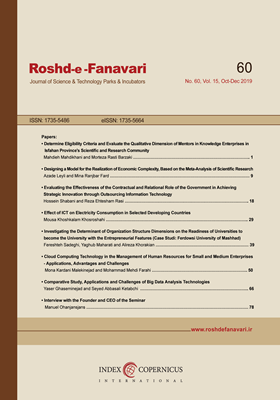Cloud Computing Technology in the Management of Human Resources for Small and Medium Enterprises - Applications, Advantages and Challenges
Subject Areas : توسعه مدلهای کسب و کار در بنگاههای کوچک و متوسطMona Kardani malekinezhad 1 , Mohammad Mahdi Farahi 2
1 - Ferdosi University
2 - Ferdosi University
Abstract :
In recent years, the advent of cloud computing has brought significant advances in the IT industry, and business management. One of the most important advantages of this technology is its reduced cost and the ability to seamlessly manage resources without the need for costly deployment of multiple infrastructures and software, and is thus widely used in the deployment of management systems and systems in organizations. Cloud computing technology has also been widely used in human resource management systems. In many cases the implementation and deployment of multiple HRM systems and software, especially for small and medium-sized organizations, entails numerous costs. Cloud computing technology is a tool that allows organizations to form and manage management systems, including their own human resource management systems, in a seamless, low-cost cloud environment. The purpose of this study is to explore the applications, advantages and challenges of cloud computing technology in human resource management, and its implementation requirements especially in small and medium enterprises. The study was carried out through library method and literature review. And it has attempted to review how literature and the requirements of cloud computing are applied in human resource management by reviewing literature and research in this area. Based on the findings of this study, the applications of cloud computing in human resource management systems in SMEs are widespread. This technology can be used in talent recruitment, training and development of human resources, compensation management systems, and human resource management and evaluation. Also, the advantages and challenges of this technology in human resource management of small and medium-sized enterprises can be categorized into two general categories, including internal and external factors. Internal advantages and challenges include technical, security, human, and financial factors, and external factors include environmental and legal factors. The applications and advantages and challenges of this technology are described in detail in the HRM systems of SMEs. The findings of this study can serve as a basis for companies and organizations to manage small organizations using and utilizing cloud computing technology in human resource management systems.
1- جعفرنژاد چقوشی، احمد، مجتوبی دلویی، احسان، مختارزاده گروسی، نیما، پیشبینی انتشار فناوری رایانش ابری در ایران بهوسیله منحنیهای رشد و اثرات روند انتشار سایر کشورها، فصلنامه مدیریت توسعه فناوری، شماره 4، ص 125-97، بهار 1395.
2- عاشوری، مریم، جوریان، نجمه، خوشالحان، فرید، رایانش ابری از دید کسب و کار ارائه راهبردهای مناسب برای خذف یا کاهش ضعفها و تهدیدات، فصلنامه رشد فناوری، شماره 42، ص 39 -30، بهار 1394.
3- ملکزاده، غلامرضا، خندهرو، نرگس، تورج، صادقی، بازاریابی در شرکتهای فناور کوچک و متوسط نوپا؛ چالشها و راهکار، فصلنامه رشد فناوری، شماره 43، ص 43 -38، تابستان 1394.
4- Wen Yeh.C,” Cloud computing and human resources in the knowledge era,” Human Systems Management 31, pp. 165–175, 2012.
5- Kumar.S.N and Kumar.S.S,” Advancement of Human Resource Management with Cloud Computing,” International Journal of Research in Engineering Technology and Management, pp. 1-6, 2014.
6- Wang. X. L, Wang. Li, Bi.Z, Yang.Y. Li, and Xu.Y,” Cloud computing in human resource management (HRM) system for small and medium enterprises,” Int J Adv Manuf Technol, 2016.
7- Ghaffari.K, Soltani Delgosha.M and Abdolvand.N, “Towards cloud computing: A SWOT analysis on ITS adoption in SMES,” International Journal of Information Technology Convergence and Services (IJITCS), pp.13-20, 2014.
8- Bhadani.R,” A New Dimension in HRM: Cloud Computing,” International Journal of Business and Management Invention, pp 13-15, 2014.
9- Marston. S, Li. Z, Bandyopadhyay. S, Zhang. J, and Ghalsasi. A, “Cloud computing: the business perspective,” Decision Support Systems, pp.176–189, 2011.
10- Stallings. W,” Data and computer communications,” Pearson/Prentice Hall, pp. 202-245, 2007.
11- Mell. P, and Grance. T, (2011) The NIST Definition of Cloud Computing, NIST Special Publication 800-145 [online] http://csrc.nist.gov/publications/nistpubs/800-145/SP800-145.pdf.
12- Khan.I,” Why Businesses (SMEs) should adopt Cloud Computing”, M.S thesis, Facalty of graduate school of Oulu University of Applied Sciences, 2015.
13- Mahmood. Z, and Hill. R, “Cloud Computing for Enterprise Architectures,” Computer Communications and Networks, 2011.
14- Linthicum, D. (2009). Defining the Cloud Computing Framework: Refining the concept. Available from: http://cloudcomputing.sys-con.com/node/811519 Accessed 23.03.14.
15- Rimal, B. P., Jukan, A., Katsaros, D., and Goeleven, Y., Architectural requirements for cloud computing systems: an enterprise cloud approach. Journal of Grid Computing.9: pp. 3–26. 2011.
16- Fazli. S, Shirdastian.H and Laroche. M, “Effective factors of successful cloud marketing adoption by SMEs: the case of Iran,” Int. J. Business Environment, pp.415-434, 2015.
17- Cisco. (2015). Cisco Global Cloud Index: Forecast and Methodology, 2014–2019. Retrieved 3 9, 2016, from: http://www.cisco.com/c/en/us/solutions/collateral/serviceprovider/global-cloud indexgci/Cloud_Index_White_Paper.pdf.
18- Columbus, L. (2015, 1 24). Forbes. Retrieved 3 13, 2016, from:http://www.forbes.com/sites/louiscolumbus/2015/01/24/roundup-of-cloud-computing-forecastsand-markete stimates.
19- Kumar. R,” Cloud Technology and Human Resource Management,” Annual Research Journal of SCMS, Pune, pp.82-91, 2017.
20- Xue. C.T.S, Xin. F.T.W, “Benefits and Challenges of the adoption of cloud computing in budiness,” International Journal on Cloud Computing: Services and Architecture (IJCCSA), 2016.
21- Widyastuti. D, Irwansyah,” Benefits And Challenges Of Cloud Computing Technology Adoption In Small And Medium Enterprises (SMEs),” Advances in Economics, Business and Management Research (AEBMR), volume 41 4th Bandung Creative Movement International Conference on Creative Industries 2017 (BCM 2017), pp.241-246, 2017.
22- Mohabbattalab. E, von der Heidt.T, Mohabbattalab.B,” The perceived advantages of cloud computing for SMEs,” GSTF Journal on Computing (JoC), pp. 61-65, 2014.
23- Sandeep. K, Rachana.C.R,” Cloud Computing - Challenges Ahead for Human Resource Managers,”International journal of scientific research, 2014.


